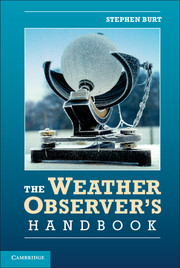Book contents
- Frontmatter
- Contents
- Acknowledgements
- Abbreviations, footnotes and references
- Part One The basics
- Part Two Measuring the weather
- 5 Measuring the temperature of the air
- 6 Measuring precipitation
- 7 Measuring atmospheric pressure
- 8 Measuring humidity
- 9 Measuring wind speed and direction
- 10 Measuring grass and earth temperatures
- 11 Measuring sunshine and solar radiation
- 12 Observing hours and time standards
- 13 Dataloggers and AWS software
- 14 Non-instrumental weather observing
- 15 Calibration
- 16 Metadata – what is it, and why is it important?
- Part Three Making the most of your observations
- Appendix 1 Metrology and meteorology: The basics of instrument theory
- Appendix 2 Useful functions
- Appendix 3 Unit conversions
- Appendix 4 Useful sources
- Index
- References
5 - Measuring the temperature of the air
Published online by Cambridge University Press: 05 July 2012
- Frontmatter
- Contents
- Acknowledgements
- Abbreviations, footnotes and references
- Part One The basics
- Part Two Measuring the weather
- 5 Measuring the temperature of the air
- 6 Measuring precipitation
- 7 Measuring atmospheric pressure
- 8 Measuring humidity
- 9 Measuring wind speed and direction
- 10 Measuring grass and earth temperatures
- 11 Measuring sunshine and solar radiation
- 12 Observing hours and time standards
- 13 Dataloggers and AWS software
- 14 Non-instrumental weather observing
- 15 Calibration
- 16 Metadata – what is it, and why is it important?
- Part Three Making the most of your observations
- Appendix 1 Metrology and meteorology: The basics of instrument theory
- Appendix 2 Useful functions
- Appendix 3 Unit conversions
- Appendix 4 Useful sources
- Index
- References
Summary
Air temperature is the first element reviewed in this section of the book, as for many this will be the first or highest measurement priority. This chapter describes how the temperature of the air is measured, and the main difficulties involved in obtaining accurate and representative measurements. Recommendations on siting and instruments from the World Meteorological Organization (WMO) are included [1], followed by country-specific details most relevant to the United States, the United Kingdom and the Republic of Ireland. Recommendations on observing practices in other countries can generally be found on that country or region’s state weather services web pages [2]. A brief summary is given at the end of the chapter.
Methods for making grass and earth temperature measurements are covered in Chapter 10.
What is meant by ‘air temperature’?
The ‘temperature’ of a body is a measure of the heat energy of that object, itself a measure of the kinetic energy of the atoms or molecules of which the object is composed. Temperatures are measured with reference to defined fixed scales set out in terms of physical changes in state of various substances, such as ice and water for temperatures within normal meteorological ranges [3]. In international meteorological and climatological use, temperatures are normally expressed in degrees Celsius (°C), although the older Fahrenheit scale (°F) is still in general public use within the United States. Temperature intervals are expressed in Celsius degrees (degC) or Fahrenheit degrees (degF): 1 degC is also identical to 1 Kelvin, a measure of absolute temperature, where absolute zero = 0 K (= – 273.15 °C). A conversion table from °C to °F is given in Appendix 3.
- Type
- Chapter
- Information
- The Weather Observer's Handbook , pp. 89 - 123Publisher: Cambridge University PressPrint publication year: 2012



